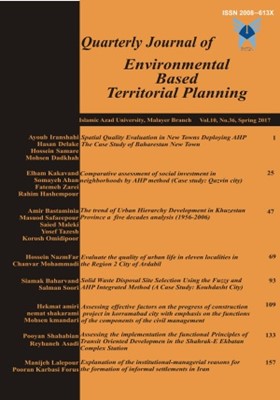Assessing the implementation the functional Principles of Transit Oriented Development in the Shahrak-E Ekbatan Complex Station
Subject Areas :
Reyhaneh Asadi
1
,
Reyhaneh Asadi
2
1 - MScs. of Urban Planning, Islamic Azad University, Central Tehran Branch, Tehran, Iran
2 - MScs. of Urban Planning, Islamic Azad University, Central Tehran Branch, Tehran, Iran
Received: 2015-10-27
Accepted : 2016-08-15
Published : 2017-05-22
Keywords:
AHP,
TOD,
functional Principles,
Subway,
Complex Station,
Shahrak-E Ekbatan,
Abstract :
Today Transportation is known as a one of the most important elements of urban development structur. Public Transportation, according to its more extensive functional capacity, can play a role in a wider scale. Transit Oriented Development with a focus on subway is one of the special approaches in this field. Recently, Tehran Public Transport Fleet has been significantly improved especially in the field of subway and BRT. Although Tehran has the potential, not only it could not benefited from the advantages of this development, but also has imposed many social and traffic problems of around of stationary complex. These are because of lack of implementation principle of TOD and the proper functioning of them. Shahrak-E Ekbatan complex is a Newly established which located on Tehran subway line 4. Since construction of the station in the standard form requires certain predetermined principles, Shahrak-E Ekbatan Complex Station with its special location in Public Transportation System is expected that it plays role in implementation these principles to achieve an efficient station complex. TOD is a novelty and different approach of traditional theory, with considering four main principles which is consisted of (1) Intensive development, (2) mixed land uses, (3) pedestrian-oriented, (4) Transportation facilities. TOD tries to solve the problems which are occurred due to inattention to the four foregoing principles. In this study, the functional principles of Transit Oriented Development in the Shahrak-E Ekbatan Complex Station are assessed with use of library and archives of the context the Field oriented descriptive and AHP. Consequently achievement to TOD goals and effective utilization of the complex station are restricted. As a main result the Shahrak-E Ekbatan Complex Station with the implementation rate of three forth of the functional principles is in desirable condition.
References:
بهزادفر، م، ذبیحی، م.1390، راهنمای برنامهسازی حوزههای شهری در چهارچوب توسعه مبتنی بر حملونقل عمومی، فصلنامه علمی پژوهشی باغ نظر،18(8): 48-37
خاکساری، ع، طهماسبی، ش.1390، توسعه حملونقل همگانی محور، یازدهمین کنفرانس سیستم بینالمللی مهندسی ترافیک و حملونقل، برج میلاد:13-1
راهنورد، بابک،1388، نقش کارآمد مجتمعهای ایستگاهی مترو در توسعه اقتصادی اجتماعی شهر تهران، هشتمین همایش حملونقل ریلی،17-1
رفیعیان، م، عسگری تفرشی، ح. 1388، بررسی الگوی عرضه زمین در محدودههای اطراف ایستگاه مترو با استفاده از دیدگاه مخاطب محور، دو فصلنامه مدیریت شهری،24: 93-81
رضابیگی ثانی، ر، شیرمحمدی، ح، رضابیگی ثانی، ف.1390، بررسی ابعاد مختلف کاربست رویکرد توسعه مبتنی بر حملونقل در کلانشهرها و شهرهای جدید، یازدهمین کنفرانس بینالمللی مهندسی حملونقل و ترافیک،20-1
زبردست، اسفندیار،1389، کاربرد فرآیند تحلیل سلسله مراتبی در برنامهریزی شهری و منطقهای، نشریه هنرهای زیبا، شماره 1380،21-13
ساریخانی، م.1383، مجتمع ایستگاهی، پایاننامه کارشناسی ارشد، گروه معماری دانشگاه آزاد اسلامی واحد تهران مرکزی
صرافی، م، محمدیان، ح. 1391. امکانسنجی پیاده راهسازی خیابانهای مرکز شهر همدان، فصلنامه آمایش محیط،21(6): 138-112
عباس زادگان، م، رضازاده، ر، محمدی، م. 1390، بررسی مفهوم توسعه مبتنی بر حملونقل همگانی و جایگاه مترو شهری تهران در آن، فصلنامه علمی پژوهشی باغ نظر،17(8):15-1
فرزاد بهتاش، م. 1383، امکانسنجی و برنامهریزی فضایی مجتمعهای ایستگاهی مترو، پایاننامه کارشناسی ارشد، دانشگاه تربیت مدرس،320 صفحه
فری، ه.1383، طراحی شهری بهسوی یکشکل پایدارتر شهر، حسین بحرینی، نشر شهرداری تهران، شرکت پردازش و برنامهریزی شهری
کاشانی جو، خشایار، 1389، پیاده راه ها، انتشارات آذرخش، چاپ اول،217-1
لاریمیان، ت، صادقی، آ، عبدالله، ب. 1390، اولویتبندی شاخصهای مؤثر در پیادهسازی رویکرد توسعه مبتنی بر حملونقل همگانی با بهکارگیری تحلیل سلسلهمراتب فازی، یازدهمین کنفرانس بینالمللی مهندسی حملونقل و ترافیک،16-1
منتظری، محمد،1391، مجتمعهای ایستگاهی راهکاری نوین در تأمین مالی پروژههای حملونقل درونشهری، دوازدهمین کنفرانس بینالمللی مهندسی حملونقل و ترافیک،17-1
هدایتی، ج.1381، توسعه با محوریت حملونقل عمومی، مجموعه مقالات ارائهشده برای همایش تهران با مترو، شرکت مترو
نظریان، ا، گودرزی، د.1391، ساختار فیزیکی کالبدی شهرها و نقش آن در ترافیک شهری، فصلنامه آمایش محیط،23(6): 50-28
Calthrope, P. (1993). the Next American Metropolis (Ecology, Community and American Dream) Princeton, N.J: Princeton Architectural Press.
CANPZD. (2006). Transit Oriented Development (TOD) Guidebook, City of Austin Neighborhood Planning and Zoning Department, Austin: Metropolitan Council
Daisa, J. M. (2004). Traffic, Parking, and Transit- Oriented Development, The NewTransit Town;Best Practices In Transit-Oriented Development, Washington, Covelo & London: Island Press.
Doina Olaru, Brett Smith, John H.E. Taplin(2011) Residential location and transit-oriented development in a new rail corridor, Transportation Research Part A 45, 219–237
Fernanda,b. (2012),A Proposal of indicators for evaluation of the urban space for pedestrian and cyclists in access to mass transit station,15th meeting EURO working Group on Transportation,Social and Behavioral Scinecees(54),44-62
Greenberg, Ellen. (2004). Regulations Shape Reality: Zoning for Transit-Oriented Development,The New Transit Town; Best Practices In Transit-Oriented Development, Washington, Covelo &London: Island Press
Keith A. Ratner, Andrew R. Goetz, (2013) The reshaping of land use and urban form in Denver through transit-oriented development, Cities 30, 31–46
Transit-Oriented Development Guidebook, City of Austin Neighborhood Planning and Zoning Department, January, 2005
Valley Connections. (2001). Model Transit-Oriented District Overlay Zoning Ordinance, Prepared for Valley Connections, Valley, Community Design and Architecture, Inc.
www.Copenhagenet.dk
www.Lenspoden.com
www.vieux.montreal.qc.ca
_||_


